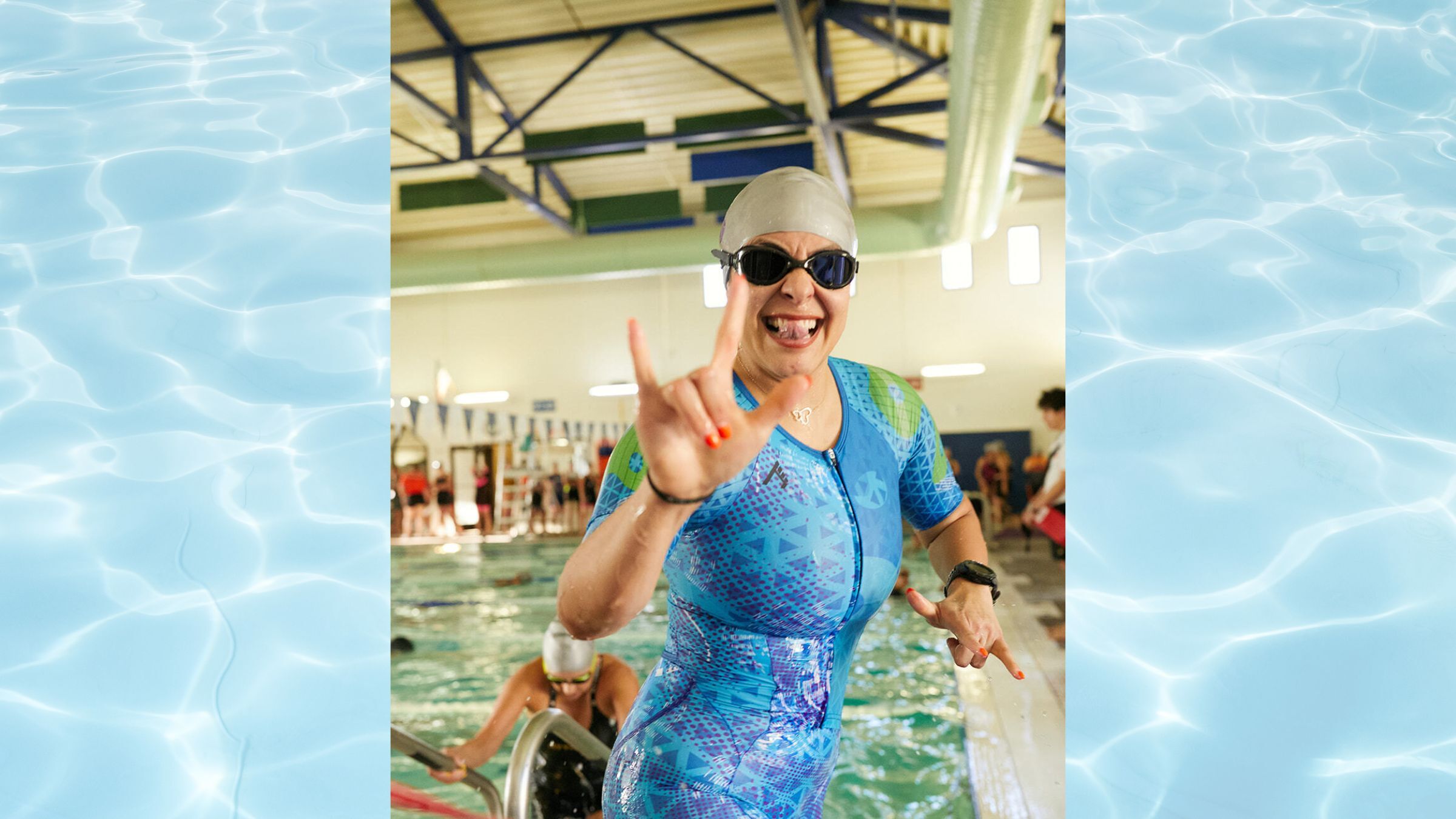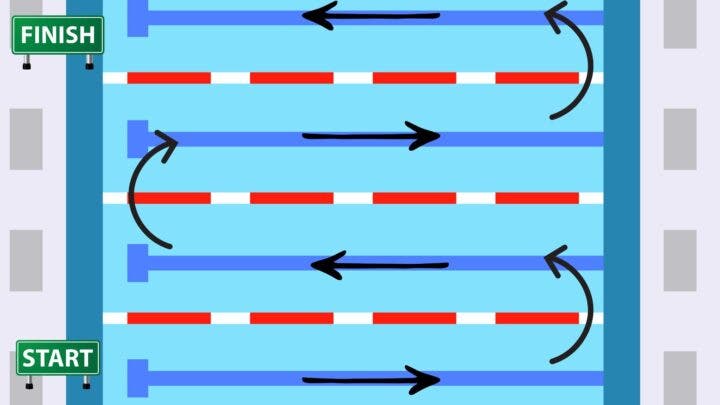Why You Should Try a Pool-Swim Tri

Pool swim triathlons offer a great entry point for athletes considering the sport. (Photo: Mighty Mujer Triathlon)
Pool Swim Triathlons
Triathlons with a pool swim (versus an open-water swim in an ocean, bay, lake, or river) are a popular choice among experienced triathletes for a fun, local community event, and they’re ideal for beginning triathletes intimidated by the challenges of open water. Note that a pool-swim triathlon does not equate to an indoor triathlon, which takes place entirely in a gym on a stationary bike and treadmill, and is especially popular in the winter months when the weather is unfavorable.
Here’s how pool tris typically work:
- When registering, you give a projected swim time for the distance and are seeded accordingly.
- The races use a time-trial start, where the fastest swimmers start first with an interval (about 10 or 20 seconds) between athletes.
- Then you usually split lanes with other athletes or serpentine the pool (snake back and forth the entire width) until you hop out to transition to the bike, typically in the pool parking lot.
- The rest of the race is just like any other triathlon, taking place on nearby roads and trails.
Want to dive into pool tris? Here’s what you need to know before you get started.
If I complete a pool-swim tri, am I still a triathlete?
Of course! If you doubt the legitimacy of a triathlon that’s not in open water, Terry Casey, a USAT- and USA Swimming-certified coach and pro triathlete, says to think again. “A pool-swim tri is a ‘real’ triathlon – there are the traditional three events that make it so!” Casey should know – based in Albuquerque, N.M., her athletes have more pool-swim race options than open-water options in the arid, land-locked state.
Now if you’re a more competitive triathlete, a pool swim can be a little frustrating. Athletes are seeded according to projected swim time, so you won’t necessarily know where you stand within your age group before the race is over. But “that could be an advantage,” Casey says, “because it forces you to really push it and give it your all.”
Why choose a pool-swim triathlon?
The advantages of a pool swim are most obvious for beginner triathletes or those who are anxious in open water. “The black line on the bottom of the pool and the consistent walls provide familiarity, a built-in safety factor, a more controlled environment, and are less intimidating,” Casey says.
Lifeguards can view and reach athletes extremely quickly in a pool, making it a safer swimming environment in emergencies. Canceled swims due to temperature, pollution, or weather are less likely, and you don’t have to worry about the craziness of a mass start or squeezing into and peeling off a wetsuit.
Pool swims also give you one less thing to worry about fitting into your schedule: open-water training. You don’t need to worry about learning how to sight buoys, manage waves, or deal with marine life. And many times, they’re more convenient (especially if you don’t live near large bodies of water) and are simpler logistically.
How many laps in a pool is a sprint triathlon?
The number of laps depends on the length of the swim, the size of the pool, and the number of lanes. Pool-swim tris typically range from 200 to 500 meters.
So say you’re racing a 400-meter swim in a 25-meter pool. The start will likely be at the first lane of the pool, and you’ll swim the full length of the lane, turn at the wall, and swim back down the same lane to complete one lap (or two lengths) of the pool. Then you’ll swim under the lane line to the next lane and repeat the process until you complete a lap in all eight lanes of the pool, so eight laps for 400 meters.
However, in larger 50-meter pools, you might have 10 lanes and only swim the length of each lane once before moving onto the next lane for five laps and a 500-meter swim.

To make the most of your pool-swim tri, Casey recommends practicing your flip-turns under the lane lines, a skill you’ll need if you swim serpentine through the pool. (For novices, practice touching the wall and pushing off at an angle.) Also, do your research ahead of time – check out beforehand which way the serpentine swim flows (clockwise vs. counterclockwise) and then practice it, and know how the swim finishes (e.g., does it finish at a ladder before the end of the pool?).
What do you wear to a pool-swim triathlon?
Pool-swim triathlons typically require the same gear as open-water triathlons, minus the wetsuit. The simplest solution to wear on race day is a triathlon suit, a one- or two-piece suit made from breathable and moisture-wicking material with a built-in thinner chamois (pad) for the bike and some storage pockets for nutrition and essentials.
If you’re not ready to invest in a tri suit, though, you can get by with a swimsuit for the swim – many women throw on bike shorts and a T-shirt over it for the bike and run, especially for a sprint-distance race. Men can wear jammers or swim briefs and then throw on a T-shirt for the bike, but they will likely experience some discomfort on the bike without a chamois, especially for races longer than a sprint.
For the swim, you’ll also need goggles and a swim cap (typically provided by the race). You’ll transition to either cycling shoes (if you’re used to racing with clipless pedals) or running shoes for the second leg, along with a helmet and maybe sunglasses, before hopping on your bike. For the run, you can swap your helmet out for a hat, depending on the sun protection needed, and switch to running shoes if you’re not already wearing them.
Required gear for pool triathlon
- Swimwear or a tri suit
- Goggles
- Swim cap (most races provide one)
- Running shoes
- Helmet
- Bike
Optional gear for pool triathlon
- Cycling shoes for use with clipless pedals
- Sunglasses
- Hat for sun protection during the run
Is a pool-swim triathlon good for beginners?
Absolutely – a pool-swim triathlon is a great option for beginners, especially if they are intimidated by open water or are nervous about the competitive nature of open-water swimming. Because of the obvious logistical challenges, almost all pool-swim tris are kept to a small number of athletes, and they’re almost all sprint or super-sprint triathlons.
Also, if a beginner lives far from a large body of water but has a pool-swim tri near their house, it allows them to focus their energy on the actual race more than the logistics – they can wake up in their own bed on race morning, have access to their own kitchen, drive their own car, and know the local roads to get to the race site. And because of the shorter distance and compact course layout, they’re typically pretty spectator-friendly, so you can invite your family and friends to cheer you on.

The small nature of pool-swim tris means they’re typically fun local races with huge support from the community, Casey says. And for non-beginners, the short courses can be a chance to test your top-end speed. “Go for it,” says Casey, “and enjoy the sufferfest!”
Pool tris around the country
Ready to dive into – er, safely jump feet first into – your first pool-swim triathlon? Check out these 2025 races around the country.
Pasadena Triathlon
March 8, 2025
Pasadena, California
This “reverse triathlon” has you complete the 5K run and 15K bike in loops around the iconic Rose Bowl stadium before swimming 150 meters (three laps) in the Rose Bowl Aquatic Center. Race day also includes a junior triathlon for kids ages 5-10, a duathlon, and a 5K.
Tri 4 the Cure AZ
March 8, 2025
Anthem, Arizona
Race a super-sprint or sprint-distance pool swim in this Phoenix suburb for a great cause – funds from the race go toward organizations fighting breast cancer as well as other local charities.
Oro Valley Triathlon and Duathlon Festival
March 15, 2025
Oro Valley, Arizona
Race either 300 meters (sprint distance) or 750 meters (intermediate distance) in an Olympic-size pool before enjoying the scenery on the bike and run in this Tucson suburb.
Smithfield Sprint Triathlon
April 5, 2025
Smithfield, Virginia
If you enjoy sleeping in, this is the race for you – the race kicks off at 10 a.m. Hosted by the Luter Family YMCA, you’ll swim 300 meters in the pool before conquering flat and fast bike and run courses around southeastern Virginia. Then enjoy a post-race barbecue meal.
CaveMan Triathlon
April 6, 2025
Flower Mound, Texas
Centered around the 25-yard Flower Mound Community Activity Center pool, you’ll swim 275 yards in the natatorium followed by a relatively flat 11.5-mile bike course and a flat 5K run in this “loin cloth-loving” themed race.
Meek & Mighty Triathlon
April 26, 2025
St. Petersburg, Florida
This counterpart to the long-standing St. Anthony’s Triathlon is open to both youth and adults and features a 200-yard swim in the North Shore Pool, a 5.4-mile bike, and a 1-mile run.
Tupelo Sprint Triathlon
April 26, 2025
Tupelo, Mississippi
Race a triathlon in Elvis Presley’s hometown – athletes will swim 300 meters at the Tupelo Aquatic Center, ride 11 miles past the birthplace of Elvis, and finish with a 5K trail run.
Mini MightyMan Triathlon
April 27, 2025
East Meadow, New York
Swim 400 meters in a newly built 50-meter pool at Nassau Aquatic Center then ride 6 miles on closed roads around Long Island and run 2 miles through a park.
TriByKnight Triathlon
May 3, 2025
Waverly, Iowa
Now in its 14th year, this tri is a popular early-season event in the area and takes place on the Wartburg College campus. It starts with a 300-yard swim in the school’s state-of-the-art natatorium followed by a 15-mile bike and 3.1-mile run.
Polar Bear Triathlon
May 3, 2025
Brunswick, Maine
Kick off tri season in New England with this Tri Maine-organized race. It combines a 525-yard pool swim with an 11.5-mile bike on country coastal roads, and a fast 3-mile run on hard-packed trails and quiet neighborhood streets.
Mighty Mujer Triathlon El Paso
May 3, 2025
El Paso, Texas
The Mighty Mujer races were founded in 2012 to open the sport to women of color with an inclusive and supportive race experience. This women-only race features a 300-meter swim in a 25-yard pool, and then athletes select either super-sprint (9.3-mile bike, 2-mile run) or sprint distance (18-mile bike, 3-mile run) for the rest of the race.
Spring Fever Triathlon
May 4, 2025
Jenks, Oklahoma
Held at the Olympic-size pool in Jenks Aquatic Center south of Tulsa, athletes swim 400 meters before getting a tour of Green County on the 12-mile bike and 2-mile run course.
Pioneer Spirit Triathlon
May 10, 2025
Petersburg, Illinois
Whether you select the sprint (300-yard swim) or “mini” (100-yard swim) distance, you get to swim in a heated indoor pool before you head out on the bike and run courses around central Illinois.
Alaska Women’s Gold Nugget Triathlon
May 19, 2025
Anchorage, Alaska
This women-only sprint-distance event, which includes a 400-yard pool “snake swim” in a 50-yard pool, sells out its 1,600 registration slots every year. Alaska’s stunning natural beauty provides a backdrop for the 12.1-mile bike and 3.25-mile run.
Annual Memorial Triathlon
May 24, 2025
New Brighton, Pennsylvania
In the 20th running of this local race, athletes will complete a 300-meter pool swim, a hilly 11-mile bike ride, and a hilly 5-mile run.
North Knox Sprint Triathlon
May 25, 2025
Knoxville, Tennessee
Swim 150 yards in the Tennova Family YMCA’s indoor/outdoor pool before hopping on your bike for a hilly but scenic 9.5-mile bike, and then complete a 5K run.
Princeton Triathlon
June 7, 2025
Princeton, New Jersey
Historic Princeton plays host to this super-sprint triathlon – swim 300 meters in an Olympic-size pool, ride 5 miles around the city, then finish with a 1.5-mile run on a paved running path around a park.
Columbia Association Triathlon
June 22, 2025
Columbia, Maryland
Staged at Clemens Crossing Pool, athletes race either the super-sprint (200-yard swim) or sprint (400-yard swim) before riding on nearby roads with moderate elevation changes and running on a relatively flat paved trail.
Secret City Sprint Triathlon
June 28, 2025
Oak Ridge, Tennessee
Swim in the 100-meter (yes, you read that right) Oak Ridge pool, which features spring-fed water, with a wave start. Follow it up with a 15-mile bike and 5K run through the scenic eastern Tennessee.
Logan Triathlon
July 12, 2025
Logan, Utah
This pool-swim tri offers both sprint and Olympic distances, which both feature a pool swim, fully paved out-and-back bike course past farmlands and fields, and a mostly paved run through neighborhoods and along the Logan River.
Montana Women’s Triathlon
July 20, 2025
Helena, Montana

This women’s-only race starts at a 50-meter outdoor city pool where athletes swim in their own lane until they’re done. Then they ride a flat 10 miles through Centennial Park to Ten Mile Park and back over a mix of packed dirt, gravel and paved trails. They finish with a 3-mile run in Centennial Park.
Ballwin Triathlon
July 20, 2025
Ballwin, Missouri
The 27th edition of this popular race, which sells out most years, includes a 300-yard pool swim, 9-mile bike, and 3.4-mile run around Ballwin, a western suburb of St. Louis.
Smiley Sprint Triathlon
July 27, 2025
Clemmons, North Carolina
Named for the late Richard Smiley, a beloved triathlete in the local community, the race is a nonprofit event and rolls 100% of the proceeds back into the race or to local charities fighting brain cancer. Athletes race 300 meters in Clemmons West Pool before taking on a 20K bike, and 5K run.
Socorro Chile Harvest Triathlon
August 2, 2025
Socorro, New Mexico
Coach Casey’s favorite race in her hometown starts with a 400-meter swim in the 50-meter pool on the New Mexico Tech campus followed by a 20K bike through town and the campus, and a relatively flat 5K run through residential neighborhoods. The race, which has now been around 25 years, features a youth race (for ages 7-14) the day before.
Tri Rock Triathlon
August 3, 2025
Rockwall, Texas
Centered around the J.E.R. Chilton YMCA, athletes take on a 150-yard pool swim, 10-mile bike ride, and 5K run around this northern suburb of Dallas.
Dam ‘09 Triathlon
August 16, 2025
San Antonio, Texas
This long-standing South Texas event takes place in the historic Alamo Heights neighborhood (whose ZIP code ends in ‘09) and across Olmos Park Dam – hence the unique name. Athletes swim 400 meters in a pool, ride 9 miles through Alamo Heights and across the dam, then finish with an out-and-back 4K run before a true SA-town finish line party – full of beer, mimosas, iced coffee, and food.
Bowling Green Sprint Triathlon
August 24, 2025
Bowling Green, Kentucky
Based around Preston Miller Park, this sprint tri starts with a 400-meter swim in the 50-meter pool at the Russell Sims Aquatic Center followed by a 14-mile bike ride on Veterans Blvd. and neighborhood roadways, then finishing with a 5K run on both paved and gravel paths.
Playtri Craig Ranch McKinney Triathlon
September 14, 2025
McKinney, Texas
About 30 miles north of Dallas, this triathlon is hosted by the local Life Time Fitness, which has a 50-meter outdoor pool in which athletes race the sprint or super-sprint distances. They then ride 6 or 12 miles and finish with a 5K or 2-mile run.
Black Canyon Triathlon
September 27, 2025
Montrose, Colorado
The 24th edition of this community favorite sprint-distance triathlon offers a variety of youth divisions, teams, and even a family team division. This Great Southwest Series race features a pool swim in the Montrose Recreation District’s pool, a bike ride on paved city streets and county roads, and a paved run on sidewalks and neighborhood streets.
Wurst Tri Ever
October 12, 2025
New Braunfels, Texas
In the Texas Hill Country lies the town of New Braunfels, which was founded and settled by Germans in the 19th century (hence the race name). Athletes will swim 300 meters in the Land Park Aquatic Center, then ride 12 miles and run 2.5 miles around town before enjoying a finish line meal of – what else? – German sausage.